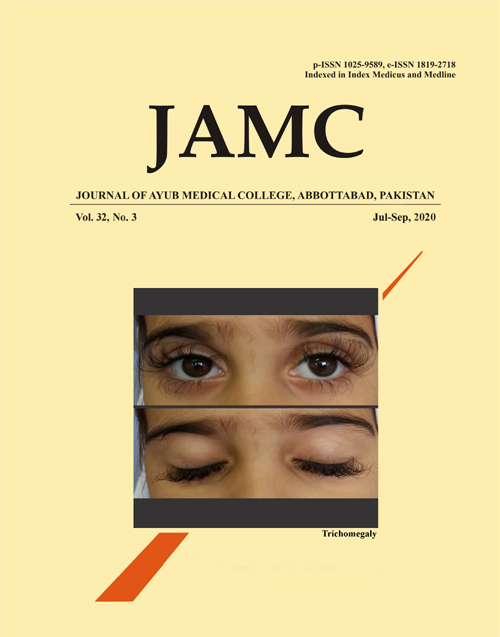MANAGEMENT OF SEGMENTAL FRACTURE OF TIBIA TREATED BY ILIZAROV EXTERNAL FIXATION
Abstract
Background: Tibial shaft segmental fractures are mostly occurring due to a high'‘energy trauma that produces a severe soft'‘tissue injury and resulting an excessive frequency of open and closed segmental fractures, and needs effective stable management. The objective of the study was to evaluate the functional outcome and union time in segmental tibial fracture treated with Ilizarov method. Methods: This prospective Qausi-experimental study was carried out from March 2014 to February 2018. Total 45 patients were included (36 males, 09 females) with a mean age of 30 years (range 20-50) with segmental tibial fractures either closed or open without any gender bar, were stabilized with an Ilizarov method. Functional outcome and bone union was assessed by ASAMI criteria. Patients were followed up to 18 months. SPSS-21.0 was used to calculate the descriptive statistics and t-test of difference between union time in open and close fractures. Results: According to Gustilo classification for open fractures, there were Grade IIIA 21 (67.7%), Grade IIIB 10 (32.2%). According to AO classification for closed fractures; 42-C1 type fractures were 5 (35.7%), 42-C2 was 6 (42.8%), 42-C3 was 3 (21.4%). Based on ASAMI criteria for bone assessment; excellent results in 26 (57.8%), good results in 16 (35.5%) and fair results in 3 (6.6%) and functional outcome was 29 (64.4%) excellent, 12 (26.6%) good and 4 (8.8%) fair was obtained. Union time difference was examined using t-statistics and score of p was greater than 0.05. This result was expected as an average time of union was almost similar in both groups, i.e., 19.83, ±11.92 in close and 20.73, ±9.09 within an open group. Overall, the union time was minimum 10.86, maximum 45.14, and median was 20.29. Conclusion: Ilizarov is an effective method for the stabilization of segmental tibial fractures because the method allows close reduction without extensive soft tissue damage and is efficient for the stabilization of short distal segmental fractures of the tibia.
Keywords: Tibia fractures; Segmental; Ilizarov external fixatorReferences
Teraa M, Blokhuis JT, Tang L, Leenen PH. Segmental Tibial Fractures: An Infrequent but Demanding Injury. Clin Orthop Relat Res 2013;471(9):2790-6.
Sultan S, Shah AA. Management of open tibial fractures at Ayub Teaching Hospital, Abbotabad. J Ayub Med Coll Abbottabad 2001;13(1):22-3.
Velazeuez RJI, Bell DF, Armstrong PF, Babyn P, Tibshirani R. Complications of use of Iliazarov technique in correction of limb deformities in children. J Bone Joint Surg Am 1993;76(3):1148-56.
Paley D1, Catagni MA, Argnani F, Villa A, Benedetti GB, Cattaneo R. Ilizarov treatment of tibial nonunion with bone loss. Clin Orthop 1989;241:146.
Rozbruch SR, Ilizarov S. Limb Lengthening and reconstructive surgery. New York: Informa Healthcare USA; 2007.
Tranquilli PL, Merolli A, Perrone V, Caruso L, Giannotta L. The effectiveness of the circular fixator in the treatment of post-traumatic nonunion of the tibia. Chir Organi Mov 2000;85(3):235-42.
Sheffer MM, Peterson HA. Opening-wedge osteotomy for angular deformities of long bones in children. J Bone Joint Surg Am 1994;76(3):325-34.
Putnam MD. External fixation for open fractures of the upper extremity. Hand Clin 1993;9(4):613-23.
Pavolini B, Maritato M, Turelli L, D'Arienzo M. The Ilizarov fixator in trauma: a 10-year experience. J Orthop Sci 2000;5(2):108-13.
Hosny G, Shawky MS. The treatment of infected non-union of the tibia by compression-distraction techniques using the Ilizarov external fixator. Int Orthop 1998;22(5):298-302.
Ozturkmen Y, KaramehmetoÄŸlu M, Karadeniz H, Azboy I, CaniklioÄŸlu M. Acute treatment of segmental tibial fractures with the Ilizarov method. Injury 2009;40(3):321-6.
Sundaram NA, Hallett JP, Sullivan MF. Dome osteotomy of the tibia for oseorthritis of the knee. J Bone Joint Surg Br 1986;68(5):782-6.
Kumar A, Whittle AP. Treatment of complex (Schatzker type VI) fractures of the tibial plateau with circular wire external fixation: retrospective case review. J Orthop Trauma 2000;14(5):339-44.
Behrans F, Searls K. External fixation of the tibia. Basic concepts and prospective evaluation. J Bone Joint Surg (Br) 1986;68:246-54.
Tucker HB, Kendra JC, Kinnebrew TF. Management of unstable open and closed tibial fractures using the Ilizarov method. Clin Orthop 1992;280:125-35.
Bonnevialle P, Cariven P, Bonnevialle N, Mansat P, Martinel V, Verhaeghe L, et al. Segmental tibia fractures: a critical retrospective analysis of 49 cases. Rev Chir Orthop Reparatrice Appar Mot 2003;89(5):423-32.
Downloads
Published
How to Cite
Issue
Section
License
Journal of Ayub Medical College, Abbottabad is an OPEN ACCESS JOURNAL which means that all content is FREELY available without charge to all users whether registered with the journal or not. The work published by J Ayub Med Coll Abbottabad is licensed and distributed under the creative commons License CC BY ND Attribution-NoDerivs. Material printed in this journal is OPEN to access, and are FREE for use in academic and research work with proper citation. J Ayub Med Coll Abbottabad accepts only original material for publication with the understanding that except for abstracts, no part of the data has been published or will be submitted for publication elsewhere before appearing in J Ayub Med Coll Abbottabad. The Editorial Board of J Ayub Med Coll Abbottabad makes every effort to ensure the accuracy and authenticity of material printed in J Ayub Med Coll Abbottabad. However, conclusions and statements expressed are views of the authors and do not reflect the opinion/policy of J Ayub Med Coll Abbottabad or the Editorial Board.
USERS are allowed to read, download, copy, distribute, print, search, or link to the full texts of the articles, or use them for any other lawful purpose, without asking prior permission from the publisher or the author. This is in accordance with the BOAI definition of open access.
AUTHORS retain the rights of free downloading/unlimited e-print of full text and sharing/disseminating the article without any restriction, by any means including twitter, scholarly collaboration networks such as ResearchGate, Academia.eu, and social media sites such as Twitter, LinkedIn, Google Scholar and any other professional or academic networking site.









